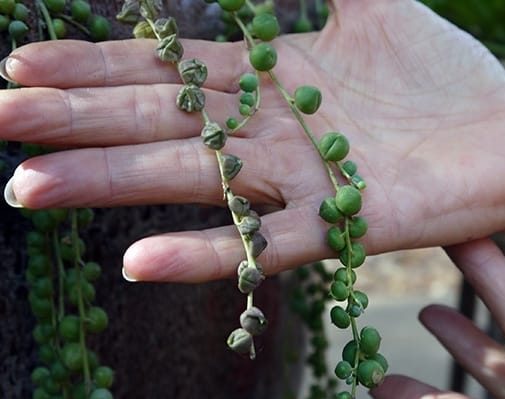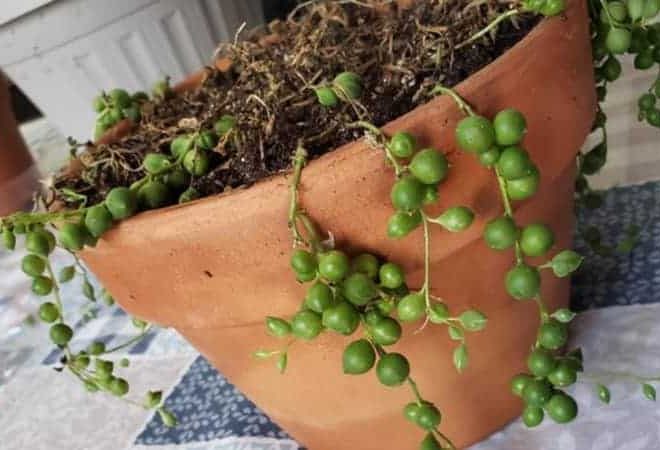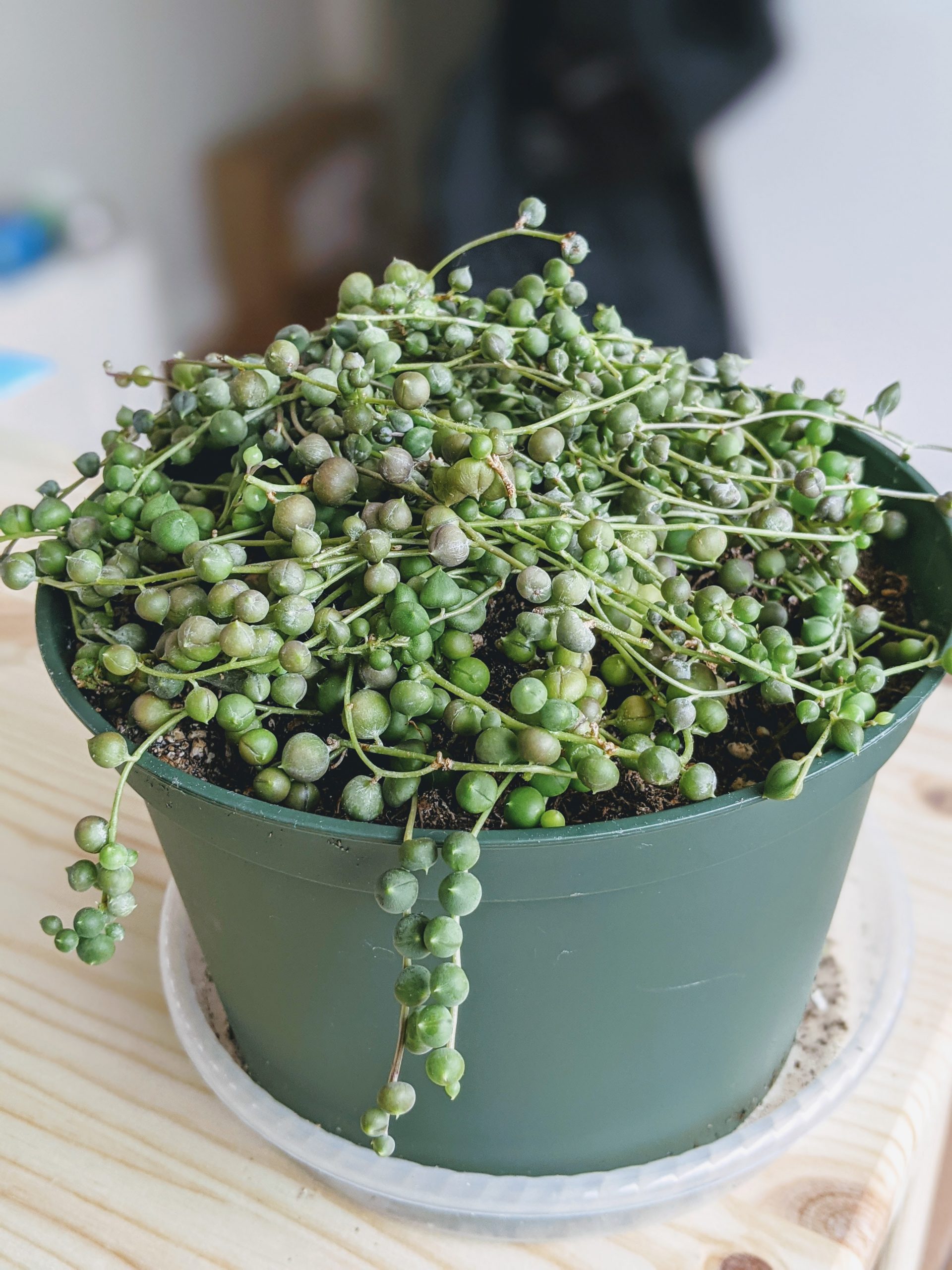
Underwatering causes string of pearl plants to turn brown and wilt. The leaves of the string of pearl are sensitive to harsh sunlight, which can burn them and cause them to become brown. They appreciate bright indirect light.
The pearls may become brown or yellow, squishy, and mushy as a result of overwatering and poorly draining soils.
Strong of Pearl plants naturally lose their older leaves as they age and turn brown.
Learn more about why string of pearl plants get brown and how to save them by reading on.
Table of Contents
String of Pearls Turning Brown and Shriveled
Underwatering is indicated if the Senecio Rowleyanus (string of pearls) plant’s leaves become dark and wilt.
Shriveled leaves are a plant’s attempt to reduce transpiration, or water loss from the leaves.
Succulents like string of pearl plants retain moisture in their leaves. The pearls are green, feel hard, and the plant appears healthy if the plant is well hydrated.
(To learn how frequently and how much to water string of pearls plants, read my post.)
String of pearls plants are more prone to overwatering since they are evolved to grow in drought-like circumstances in their native South West African setting with infrequent rainfall and well-draining grit soil.
However, occasional watering causes the potting soil to become hydrophobic because it becomes so dry (water resistant).
After a period of drought, some potting soils have a tendency to reject moisture, so when you water the plant, the water flows off the top and down the edge of the pot rather than reaching the roots where it is needed.
Then, water trickles out of the bottom of the container, giving the impression that your string of pearls has received adequate watering but, in reality, the roots have not had time to absorb any water, and the plant is practically experiencing drought, causing the pearls to turn brown and shrivel.
When growing string of pearls indoors, a few things can cause the soil to dry out too quickly and turn brown and shrivel up:
- close to a heat or air current source. When placed next to a heater, in the air conditioning, or in forced air, the soil in a potted string of pearls can heat up extremely quickly and the temperature can change substantially, which can cause drought stress.
- watering insufficiently. String of pearls is a drought-tolerant plant, but you should try to mimic the circumstances that it is used to in its natural environment by soaking the soil and letting it dry out between bouts of watering. Only the top inch or two of the soil receives hydration from light watering, which promotes shallow root growth, making plants more susceptible to drought and raising the possibility that pearls will shrivel and become brown.
- transplant shock caused by a shift of circumstances. Indoors, string of pearls thrives, but if it is transferred from one location to another, the disparity in environments may cause it to turn brown. The plant adjusts to the temperature, humidity levels, and hours of light in a given environment. Its atmosphere and moisture needs can change if you transfer it to a different room or even bring one home from the store. This is especially true if you move it from a cool, dimly lit area to a hotter, sunnier, and less humid region.
How to Revive Brown and Shriveled String of Pearl Plants
A string of pearls plant that has become brown and shriveled can be revived with the right potting mix and routine watering.
As with many succulents, string of pearls may thrive on coarse, rocky soils that are porous and have relatively high particle sizes.
If it is planted in a regular soil mixture, this can increase the danger of root rot (because they hold too much moisture) and the potting soil can dry up and resist water off the surface and down the edge of the pot, prolonging the effects of dehydration despite watering.
Repot your string of pearls in potting soil designed exclusively for cactus and succulent plants (which are available at garden centers, nursery and on amazon).
After a period of not watering, special succulent potting soil is very effective at allowing water to infiltrate the soil and reach the roots rather than run off the top and down the side of the pot because it has the right properties to allow for good drainage (so that the plants don’t suffer from overwatering).
This enables a more natural watering cycle and ideal soil moisture levels so that pearl strings can access the water and the soil doesn’t store too much moisture, which leads to rot.
How often should string of pearl plants be watered to avoid turning brown and shriveled?
Given that their watering needs might vary depending on factors including climate, solar intensity, temperature, and humidity, it is impossible to provide firm recommendations on how frequently to water pearls to prevent them from turning brown.
A certain amount of trial and error is necessary to determine the best watering frequency for a healthy plant, but since strong of pearls are adapted to harsh dry circumstances, you should normally water them much less frequently than most plants.
In the Spring and Summer when the plant is actively developing, I typically water my string of pearls once a week. In the Winter, when the plant is dormant, I water it every two to three weeks.
As a natural response to preserve moisture in harsh desert settings, strong of pearls can enter a state of Summer dormancy in extremely hot climates.
If you detect a considerable slowdown in the growth of your string of pearls or any signs of stress from excess water, such as mushy, soft leaves with some yellowing or browning, you should reduce watering to once a week.
My well-draining succulent potting mix (purchased on Amazon) encourages good drainage, which eliminates any possible issues from excessive wetness and also enables water to efficiently reach the roots after a round of watering.
This keeps the leaves on my string of pearls fresh and green, rather than shriveling or turning brown.
Read this article for the answer if your string of pearls is drying out despite proper watering habits.
Sun Burnt Leaves Turn Brown

If the string of pearls has grown accustomed to growing in an area with less intense light or possibly fewer hours of sun each day and is then transplanted to a more sunny region, the leaves may turn brown from sunburn.
Your string of pearls are more likely to burn from the sun because of the difference in solar intensity between the two sites.
Only the leaves that are in the sun’s direct glare turn brown, whereas leaves that have more shade or protection are either less burned or still remain green. This makes it easy to distinguish between string of pearls turning brown due to sunburn and string of pearls turning brown due to underwatering (or any other reason).
After being burned, individual leaves typically do not recover.
You can either take some cuttings with healthy leaves and use them for propagation, or you can clip back any sunburned pearls and let the plant develop again.
Because string of pearl plants are so simple to grow, even severely burned plants can be revived. To learn how to spread a string of pearls, view this YouTube video.
Preventing String of Pearls Turning Brown due to Sun Burn
Spring of pearls may grow in partial sun and are adaptable to hot regions, but they must not be transferred from a more shady spot to a location in the sun or they will burn.
A gradual adjustment to new circumstances is preferable to coping with a sharp contrast in light intensity for the string of pearls.
To achieve this, spend an hour each day moving your potted string of pearls plant to a more sunny location. Every two or three days over the course of a month, increase the plants’ exposure to direct light by roughly 30 minutes.
If exposed gradually, strong of pearls can eventually adapt to the new light intensity and handle larger amounts of sun without getting burned.
String of pearls prefer either strong indirect light or morning sun followed by afternoon shade because they are a bit more light sensitive than most succulents.
Remember that plants need more moisture when they receive more sun, therefore I advise watering consistently once a week to keep the leaves from drying up and turning brown.
Leaves at Base of the String of Pearls Plant Turn Brown and Drop Off
Your string of pearls plant’s leaves turning brown could also be caused by aging.
All succulents experience a natural cycle in which their bottom leaves naturally turn brown and die off as the plant ages and expands.
In plants that receive more shade, this effect might be more noticeable.
If they are in too much shade, string of pearls will grow in the direction of more light since they love some brilliant light or some morning sun.
As a result, the leaves or pearls grow more scarce, especially at the bottom of the stem. After becoming brown, the lowest leaves fall off.
All succulents are susceptible to this, but it can be prevented by growing them in more sunlight. This prevents the plant from becoming lanky and sparse and maintains it shorter and more compact.
To prevent sunburn, take care not to relocate your strand of pearls to a spot with a lot more sun all at once.
Too Much Moisture Can Cause Brown Leaves

Leaves that are turning brown, yellow, or black and feel soft and mushy rather than harder green leaves are signs of overwatered string of pearls plants.
The usual causes of excessive wetness around the roots are:
- excess watering Succulents that can withstand drought and prefer a dry environment include string of pearl plants. You are probably overwatering if you water more frequently than once per week.
- soils that drain slowly. Fast-draining soil is necessary for string of pearls. For the best soil mix, transplant strong of pearls into a specialized succulent and cactus potting mix.
- pots without base drainage holes. Without drainage holes in the base, water pools around the roots of potted plants, causing root rot and the browning of the leaves and stems. For the best results, always place string of pearls in containers with drainage holes. Remove any trays or saucers from underneath your pots to let water to freely drain.
The plant can die if the roots remain in wet soil for an extended period of time due to rot, which turns the leaves from brown to black. However, if the situation is corrected, the plant can be saved.
Depending on your environment, watering is necessary, but as a general guideline, to keep a healthy plant, wait until the soil has dried up before watering.
To promote drainage, use a specific succulent potting mix and replant the succulent in a new container with drainage holes in the base.
For the string of pearls to remain healthy, the succulent soil needs time between waterings to dry out.
Take cuttings from healthy leaves and stems to propagate new plants if the plant’s condition does not improve despite better drainage and watering techniques because the rot can eventually spread and kill the plant.
(Read my article on how to save a dying string of pearls plant for additional information.)
Bruising Can Cause Brown String of Pearls Leaves
String of pearl plants have lovely, firm leaves when they’re in good health, but if they are bumped, they could get hurt.
If the plant has been injured in some way, the bleeding may be fairly limited to only a few leaves or stems.
Because strong of pearls are delicate, handle them with care and place the plant safely away from danger.
However, persistent bruised leaves may need to be clipped for both practical and esthetic reasons. Recovery depends on the severity of the bruising, but with light brushing, the leaves can recover.
Key Takeaways:
- Underwatering causes string of pearl plants to wilt and turn brown. The leaves might become brown and burned from too much sun.
- Overwatering can make the leaves yellow or brown, mushy and soft, and can even lead to rot.
- If a string of pearls is physically harmed in some way, they may become bruised and turn brown.
- Increase watering and switch to a grittier succulent-specific potting soil to revive withered and brown string of pearl plants. Pruning may be necessary for sunburned leaves.
